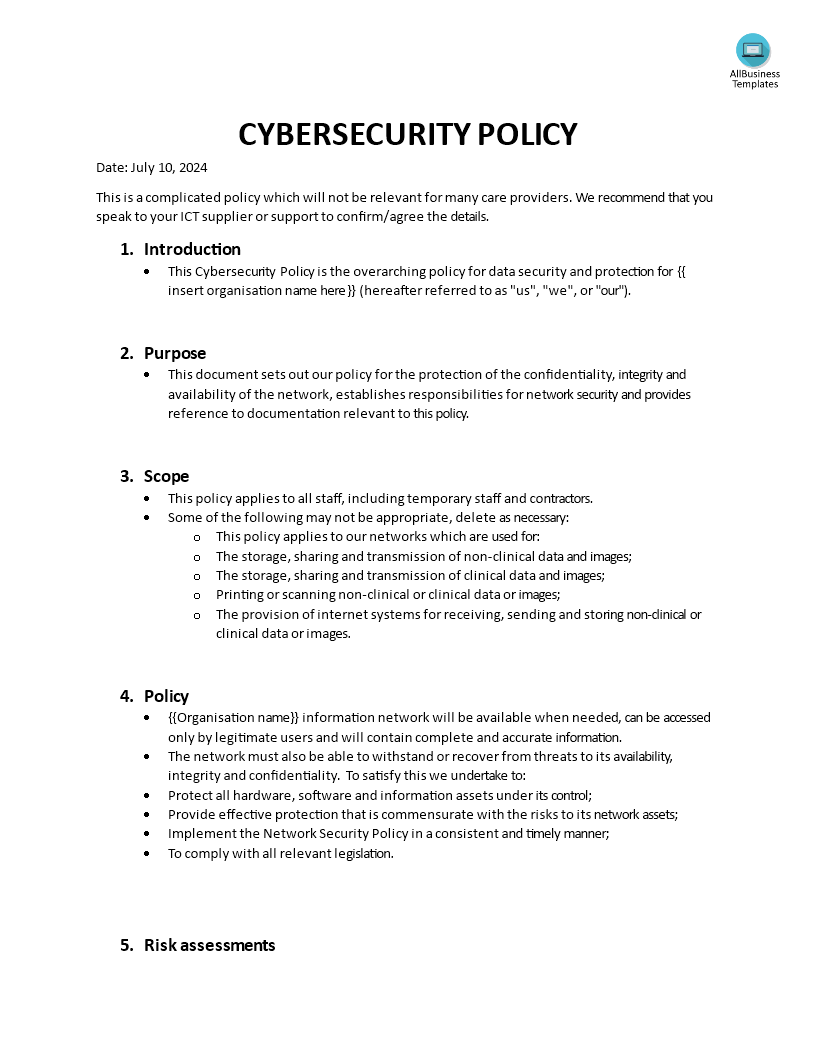Cybersecurity Policy
Save, fill-In The Blanks, Print, Done!

Download Cybersecurity Policy
Microsoft Word (.docx)Or select the format you want and we convert it for you for free:
- This Document Has Been Certified by a Professional
- 100% customizable
- This is a digital download (35.08 kB)
- Language: English
- We recommend downloading this file onto your computer.
Which steps do one need to follow while coming up with a cyber security policy? What does the content of the cyber security policy entail? To make it yours, download this cyber security policy template now and modify it as per your wish. Use it to create a secure environment for your network. Let your staff be informed about how important is cyber-security.
A Cybersecurity Policy is a set of rules that have been laid down in a formal manner meant to protect an organization’s IT systems and data from being tampered with by hackers. This paper elaborates on the control measures and actions that shall be put in place by the organization to protect its digital properties, guarantee information integrity, confidentiality, and availability as well as meet legal and regulatory requirements.
Commonly, the core components of a cybersecurity policy are as follows:
- Purpose and Scope: It highlights policy objectives and its boundaries including what systems, data, and personnel that it is limited to.
- Roles and Responsibilities: Clearly define who is in charge of enforcing, maintaining, and implementing the policy, including IT staff’s duties as well as those of management and employees.
- Risk Management: This describes how an organization will identify, assess, and respond to cyber security risks such as conducting regular vulnerability scans and risk assessments, etc.
- Access Control: This includes methods used for controlling system access like authentication/ authorization procedures password policies as well as least privilege principle.
- Data Protection: It gives guidelines on how sensitive data should be handled which include encryption, data classification, and data retention policies among others
- Incident Response: A plan or framework for responding to cybersecurity incidents including detection, reporting, containment investigation, and recovery procedures.
- Training and Awareness: Focuses on providing training programs that enhance employee awareness on how to recognize security threats.
- Compliance and Monitoring: These ensure that they adhere to relevant laws, regulations, and standards, and explain how compliance will be monitored and enforced.
- Physical Security: This focuses on the physical aspects of safeguarding IT infrastructure like securing server rooms and limiting access to sensitive areas physically.
- Network Security: This entails defending the company’s network framework including firewall or intrusion detection/prevention systems as well as secured remote access protocols.
- Software and System Security: It covers secure software development practices; patch management from a security standpoint; and regular system updates among others.
- Third-Party Security: This outlines how an organization plans to deal with cyber risks originating from third parties such as vendors or partners through security assessments and contractual obligations among other mechanisms.
Any given organization must have a well-defined cybersecurity policy in place to protect its digital assets, maintain customer confidence, and ensure uninterrupted business operations when faced with constantly evolving cyber threats.
To improve your effectiveness while ensuring everything goes smoothly you have two options: click directly on “Open with Google Docs” or get our sample cybersecurity policy template in MS Word.
DISCLAIMER
Nothing on this site shall be considered legal advice and no attorney-client relationship is established.
Leave a Reply. If you have any questions or remarks, feel free to post them below.
Latest templates
Latest topics
- Excel Templates
Where do I find templates for Excel? How do I create a template in Excel? Check these editable and printable Excel Templates and download them directly! - GDPR Compliance Templates
What do you need to become GDPR compliant? Are you looking for useful GDPR document templates to make you compliant? All these compliance documents will be available to download instantly... - Google Docs Templates
How to create documents in Google Docs? We provide Google Docs compatible template and these are the reasons why it's useful to work with Google Docs... - IT Security Standards Kit
What are IT Security Standards? Check out our collection of this newly updated IT Security Kit Standard templates, including policies, controls, processes, checklists, procedures and other documents. - Letter Format
How to format a letter? Here is a brief overview of common letter formats and templates in USA and UK and get inspirited immediately!
cheese

